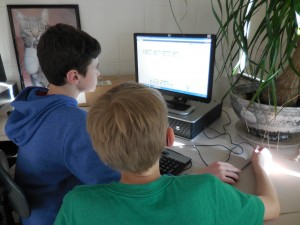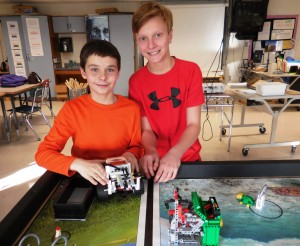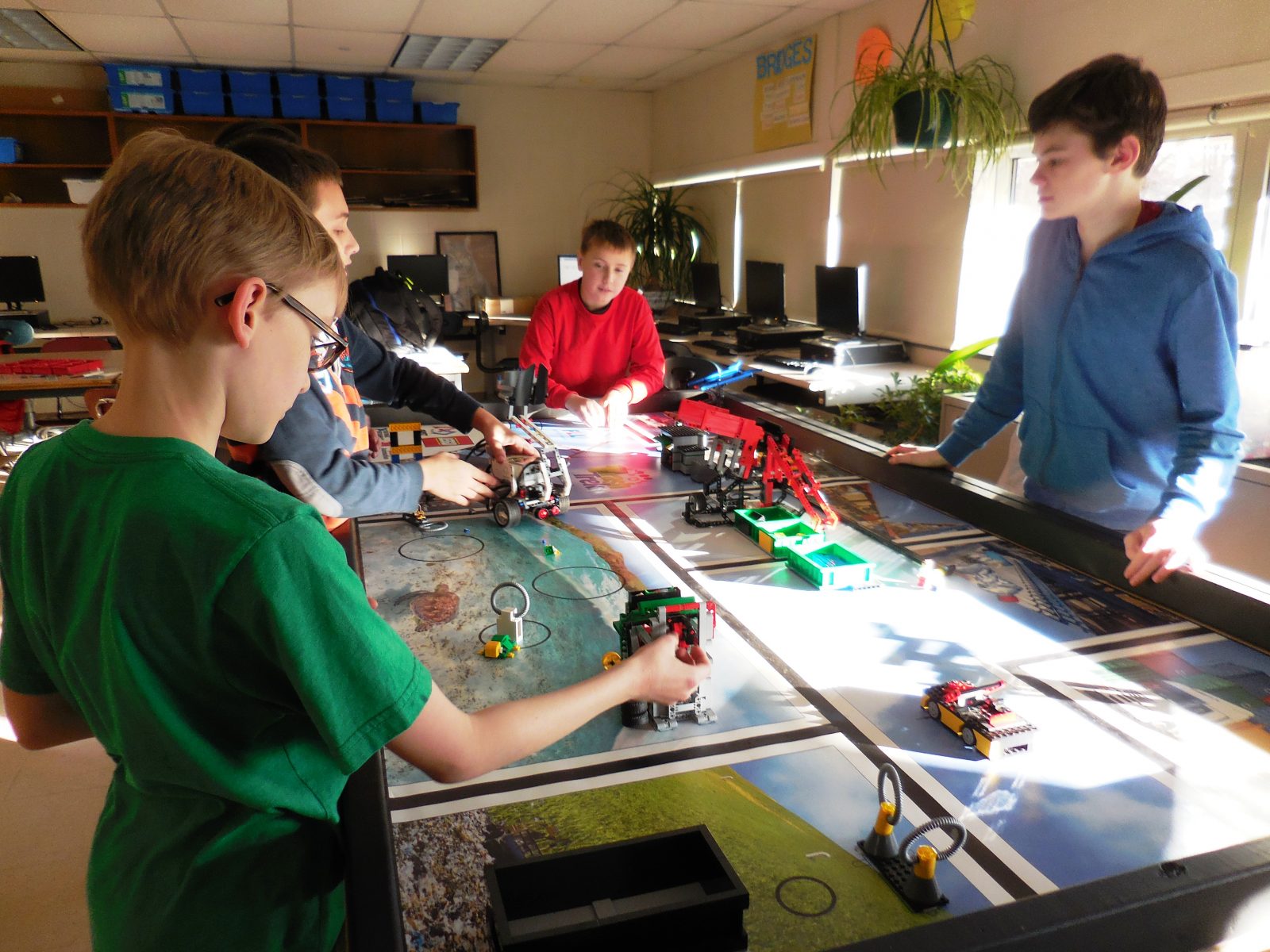
Teammates Alex Fontanilles and Charles Darling program the robot to perform tasks. (Photo by Amy Porter)
WESTFIELD – South Middle School has a new robotics program that meets after school, under the auspices of technology teacher Deborah McQuade Stewart. The program is FIRST Lego League, an international robotics competition developed by FIRST (For Inspiration and Recognition of Science and Technology) and The Lego Group.
Guided by adult coaches, FIRST Lego League teams research a real-world problem such as food safety, recycling, energy, etc., and are challenged to develop a solution. They also must design, build, and program a robot using LEGO Mindstorms and compete on a table-top playing field, “home base” for the robots.
Stewart first became interested in the program last year, when she had the opportunity through a “Girls First” grant to take some girls to UMass for a whole day of robotics.
“The kids were so enthusiastic about it,” Stewart said, that she didn’t want to stop. Someone donated an old NXT robot to her class, and she started to write some grants.
Initially, Staples donated $1,000 to get the FIRST Lego League program started this fall. Then last month, the Westfield Education Foundation awarded them another $1,500, which will enable Stewart to purchase four new EV3 Lego Mindstorm robots. “We are very grateful to both these organizations for their support,” Stewart said.
Since this is the first year of the program they will not be competing this year, but Stewart hopes to next year. She said 10-20 students participate on any given day, although lately she has lost some to seasonal intramural sports. Since the program goes all year, they have been pretty accommodating to other activities.
“Next year, when we have a competition, we’ll have to be more stringent about attendance,” she said.
The students build the robots and program them to perform different tasks on the home base, provided by the FIRST Lego League, which they must also build. Middle School South shop teacher Dan Sheehan built the table for the playing field.
The Lego kits come with an instruction book on a very basic robot, but students can expand it any way they want, Stewart said.

Seventh grade teammates Tim Nacewicz and Riley Sullivan with the robot they built for the FIRST LEGO League at Middle School South. “The robotics inspires me to be better,” Sullivan said. (Photo by Amy Porter)
“It has all the great stuff – collaboration, thinking, trial and error,” she said.
This year’s theme is Trash Trek, all about trash and how it impacts the world. The students had to put together the home base, and build different objects, such as a trash sorter, which loads different-sized Lego pieces, and sorts them into different bins according to size. The robots then must be programmed to carry the pieces to the sorter, and operate it by turning a wheel.
Other tasks include picking up and removing trash from the ocean (Lego pieces shaped like plastic bags), and putting back ocean animals, such as a sea turtle, into circled zones. Built-in sensors are programmed to follow a black line, or avoid a black line on the board. During competition, points are awarded for specific tasks, and students have two and a half minutes to complete as many tasks as they can.
Programming is done on a computer program which talks to the robots, which also work off Wifi and Bluetooth. Seventh grader Riley Sullivan downloaded the program to his phone, and uses it as a joystick to operate the robot.
“I like everything about the program,” Sullivan said, “the design, building the robot. The robotics inspire me to be better.”
Sullivan’s teammate, seventh’s grader Tim Nacewicz is also enthusiastic.
“I really like programming, and seeing the program build its course, and building parts that help (the robot) do its course,” Nacewicz said. “It really gets your brain working. To complete obstacles, you have to make different parts, and program the computer. It’s really creative.”
Now that Stewart is able to buy more robots, she plans to expand the program to her classroom, to get more students excited about it.
“Robotics is such a part of the future,” Stewart said. “They’re doing stuff now that I didn’t even dream about.”


